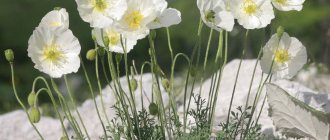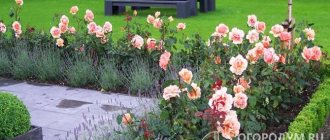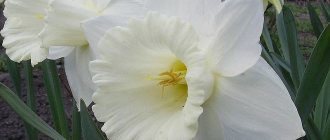Author's rating
Author of the article
Yakov Pavlovich
Professor, Head of the Department of Vegetable Growing
Articles written
153
Garden spurge, or euphorbia, is a flowering plant that gardeners value for its decorative appearance, originality, and undemanding conditions. Having decorated your plot with euphorbia once, you can admire it, monitor its development and flowering, and without making any special efforts. Planting and caring for garden perennial milkweed is not difficult, but requires knowledge of the basic rules of agricultural technology.
Description of the variety
Perennial spurge is a small, round-shaped bush. It reaches a height of 50-60 cm, a width of 100-150 cm.
The shoots are numerous and densely located. Each of them looks like a lush bouquet thanks to the bright inflorescence of small flowers. Most often they are yellow (however, the color palette, like the shape of the leaves, depends on the specific variety).
When damaged, leaves and stems secrete a rather aggressive milky sap. In small doses it has beneficial properties and is used in medicine. But when it gets on the skin in normal concentrations, it causes severe irritation, and sometimes much more severe consequences (even death).
It is important to remember that all work with garden spurge must be done with gloves.
Use in landscape design
Euphorbia is often used in landscaping. The plant looks harmonious with other flower crops. Some varieties are suitable for decorating rockeries and alpine slides. In addition to all its advantages, milkweed is also a very unpretentious plant, not demanding on growing conditions.
This crop can be planted in trunk circles
Euphorbia has long been very popular among gardeners due to its unusual appearance and ease of cultivation. From a large number of varieties, everyone can choose a variety to their liking.
Popular varieties
- Myrtifolia. A low-growing perennial that grows up to 20-25 cm. The main feature is the original diamond-shaped leaves of a bluish-gray-green hue.
- Almond-shaped (or almond). Medium-sized ornamental bush with bright light green flowers. It blooms from April to early July and does not tolerate frost.
- Purpurea. It belongs to the previous variety (full name - Euphorbia Amygd Purpurea), but is distinguished by luxurious purple leaves.
- Cypress. A half-meter shrub with narrow and thin leaves resembling pine needles. Inflorescences can be yellow, white or red.
- Multi-flowered. A common frost-resistant variety. First it acquires a light green color, and then becomes lemon. Grows up to 70 cm.
- Mediterranean (other name: Sculptural). Vertical shrub (length 1.5 m). Its carpal inflorescences and hairy stem of a bluish tint look interesting.
- Griffith. An exotic Tibetan variety with delightful scarlet flowers. Loves sandy soil and calcium supplements.
- Red-leaved. It is distinguished by dark red leaves of an oblong elongated shape.
- Bonfire multicolor. A spectacular ornamental plant with bright yellow flowers and purple leaves. Grows up to 40-45 cm.
- Official. An annual that often grows like a weed, but tends to repel rats, mice, cockroaches and bedbugs from the home.
- Capitate. A low bush with bluish leaves and original flower heads. It needs to be trimmed in time to prevent creeping shoots from spreading throughout the garden.
- Longhorned. It has pink inflorescences and green foliage. Reaches 70 cm, usually grows in the Caucasus.
- Bordered. An extremely showy plant with white edges on the leaves. Grows up to 80 cm, loves partial shade and slightly acidic soil.
Wild guest from Madagascar: is spurge harmful or beneficial, photo of the weed
Euphorbia is a perennial plant from the Euphorbiaceae family (there are more than 1000 species). Its homeland is the island of Madagascar. Over time, the climate and soil composition changed, and the plant gradually spread throughout the world.
About 100 species grow in Russia, the most common of which is wild spurge. It got its name because of the white poisonous milk that is located inside the stem. Next, you will learn about the beneficial properties of the plant, what diseases it is used for, contraindications to its use, and what it looks like in the photo.
Purchase and adaptation
Purchase garden spurge in a special store or from hand. Its prices are quite reasonable, although they depend on the rarity or prevalence of the variety.
For example, the usual myrtle-leaved variety can be bought for 80-100 rubles, and the almond-shaped Purpurea - for 200-250 rubles.
Street shrubs do not require special adaptation after purchase. However, it is worth waiting before transplanting it into the garden.
You should observe the plant for several weeks and make sure there are no pests or diseases. It is best to transplant from a container into open ground at the end of May.
Composition of milkweed juice
The milky white juice has a pungent taste, but is completely odorless. It is released from the cut of the plant and quickly hardens in the air.
The composition of milkweed juice includes: saponins, alkaloids, gum, tannins and other components.
Euphorbia is a natural aphrodisiac that increases the body's defenses. The juice of the plant has antiseptic and antibacterial properties.
Landing rules
Planting in open ground is carried out in the spring (mid-late May). The soil is loosened, and if the reaction is acidic, it is limed.
If seedlings are planted, make a hole with a diameter of 10 cm, and if the plant is transplanted from a container, make a hole the size of an earthen clod.
Expanded clay is laid underneath (for drainage), and then 4-5 cm of compost. Euphorbia is placed in a hole and sprinkled with a substrate of soil, peat and sand. Water with lukewarm water, and when the top layer dries, loosen it so that a crust does not form.
Transplanting shrubs from place to place is undesirable; if it is done, it is done no more often than once every 5 years.
How does it reproduce?
To reproduce, the wild plant uses side shoots and seeds, which it has in large quantities. This is the reason why it takes so long to get rid of the weed.
The main methods of propagating milkweed:
- using seeds;
- dividing the bush;
- leaf or stem cuttings.
If you do not completely remove the plant from the soil, new shoots will form on the remaining root system over time. The weed will begin to grow even more intensely until it turns into a bush.
Care
The plant is easy to care for
The plant is very unpretentious, no. When grown in open ground, it requires minimal care.
During dry periods, it needs to be watered, and in early spring, preventative pruning should be carried out.
The shrub needs moderate fertilizing and weeding, and some varieties need to be prepared for winter.
Selection of soil and location
It is better to plant milkweed in a sunny place (but not in direct sunlight) or in partial shade.
The shrub is unpretentious to the soil (some preferences depend on the specific variety). It usually does well on loose loams with a neutral, alkaline or slightly acidic reaction.
Fertilizers and fertilizers
Euphorbia does not need frequent feeding. On fertile soils it can do without them altogether. On soils with low amounts of minerals and organic matter, feed with a universal complex three times per season (in May, July and early September).
Watering
The shrub is drought-resistant enough to not need watering with regular rainfall. During hot and dry periods, milkweed is watered as needed. Evening sprinkling is also useful - the bush will look fresher and more decorative.
Weeding and mulching
Like other plants, milkweed needs weeding. Loosening helps improve access of oxygen, moisture and nutrients to the root system.
Mulching is carried out in the fall, before the onset of winter - peat chips are usually used.
Trimming
In early spring, bushes can be formed and sanitary pruning carried out.
Some types of perennials, like annual weeds, spread very aggressively and can take over an impressive part of the garden. These include spurge capitate and cypress. These varieties cannot be ignored; their growth must be promptly and regularly limited.
Preparing for winter
At the end of autumn, the shrubs are mulched with peat chips.
Most varieties can withstand cold weather adequately, but there are also heat-loving varieties that do not tolerate frost. These include Euphorbia Myrtifolia and Mediterranean. For the winter it is better to cover them with spruce branches.
Plant pruning
Thickened shoots are removed as needed.
Diseased, overly long and dry parts of the plant must be pruned.
Timely removal of dried flowers will stimulate re-blooming at the end of summer.
Pruning cannot be neglected: an overgrown bush will suffocate the plants in the neighborhood.
The work is carried out with gloves, because the milky juice is quite poisonous.
Reproduction methods
This species is propagated by seeds, cuttings or dividing the bush. Euphorbia can also reproduce by self-sowing. To do this, shrubs are planted in the garden in pairs - male and female.
Seeds
In the fall, the seeds are sown directly in the garden bed, in the spring - in a box for seedlings. In April, they are sown in a substrate of turf soil, sand and compost and placed in a greenhouse at a temperature of 18 -23 ° C until germination (usually this takes one and a half to two weeks).
At the stage of three true leaves, plants can be planted in pots. At the beginning of June, they are planted in open ground in a permanent place.
Cuttings
Euphorbia can reproduce by self-sowing
Cuttings are carried out in July or August. The tops of shoots 10 cm long are cut from the bush (the lower leaves and inflorescences are removed) and placed in water for a couple of hours to allow the juice to flow out. Then they are treated with Kornevin, dried and deepened into a moist substrate of sand and perlite.
The cuttings are placed in a greenhouse, regularly moistened and ventilated, until root shoots appear.
Dividing an adult plant
The shrub is propagated by division in April or at the end of August. The bush is dug up and divided into several parts so that two buds remain on each.
Immediately after this, they can be transplanted to a permanent place. For an adult plant, the procedure is carried out no more often than once every three years.
Folk recipes from milkweed
The medicinal properties of milkweed have found their application in the treatment of the following diseases:
- Tincture for the treatment of fungus, eczema and lichen. 1 teaspoon of herb is poured into 500 ml of boiling water. Let it sit for half an hour and strain. The product should be used as baths. To treat lichen, use the juice of a fresh plant, which is applied to the sore spot. Leave for 20 minutes and rinse thoroughly with water.
- Gastrointestinal diseases. 5 grams of root are poured into 1/2 liter of water. Boil the liquid for 10 minutes. Take the product 3 times a day, a tablespoon a quarter of an hour before meals.
- Getting rid of freckles or age spots. Apply the juice of the plant to your face and wash it thoroughly after 10-15 minutes.
- Treatment of calluses. This recipe has been known since ancient times. Apply the grass juice to the calluses and put on socks. The procedure is carried out at night, for 6-7 days. In the morning, wash off the juice and apply pumice.
- Depilation. To facilitate the process, add a teaspoon of plant juice to 100 grams of boiled water. Wipe the area where depilation is planned. The procedure will go faster, and the hairs will grow slower.
By using the herb euphorbia in the treatment of diseases, you can quickly reduce their symptoms.
Diseases and their treatment
| Disease | Signs | Prevention | Control measures |
| Fusarium | The leaves turn yellow and wither; A dark ring is visible on the cut; White or reddish coating on the root collar; Drying of the aboveground part of the bush. | Liming acidic soil; Moderate watering; Good drainage layer; Loosening and mulching; destruction of insect carriers; proper care. | Removal of affected parts; Replanting to a new location with healthy soil; Treatment with biological products and fungicides (Fitosporin, Fitolavin, Bordeaux mixture and others). |
| Root rot | Slow growth; Darkening of the stem; Brown spots on leaves; Drying of foliage and lodging of stems. | Calcination and disinfection of seeds before planting; Disinfection of equipment, burning of affected plants (they cannot be left in compost); Compliance with agricultural practices (proper watering and fertilizing). | Removing the damaged part of the bush, replanting it in a disinfected substrate; Treatment with drugs: Trichodermin, Trichofit, Mikosan, Discor, Copper sulfate, Vitaros. |
| Ring spot | Yellow ring-shaped spots on the leaves. | Destruction of vectors – nematodes; Disinfection of seeds, soil and garden tools | This viral disease has no cure. Affected plants should be burned. To prevent large-scale spread in the area, it is necessary to treat the weeds with herbicides and destroy nematodes. |
Contraindications to the use of milkweed
When using milkweed, we must not forget that the plant is poisonous. All products from it must be prepared with strict adherence to dosages and rules of administration.
Treatment with milkweed should be carried out under the supervision of an experienced specialist. After all, he can suggest the correct and safe regimen. With prolonged use of the plant, side effects may occur. The finished product should not get into the eyes or face; if this happens, the medicine must be washed off with water.
Main contraindications:
- individual intolerance;
- pregnancy and lactation;
- allergic reactions on the skin.
All milkweed products are contraindicated for children. Prolonged contact may cause a burn on the skin, so the affected area should be washed with water and a cold compress applied. Be sure to give your child an antihistamine.
Pests and their control
| Pests | Signs | Prevention | Treatment |
| Nematode | Dry brown spots; Drying and curling of leaves; Suppressed growth. | Burning all weeds on the site; Disinfection of soil and seeds; Spilling boiling water on the soil; Regular weeding and loosening. | Soaking the roots of the plant in hot water with formaldehyde; The use of nematicides - chemical or biological products. |
| Mealybug | Cotton-like waxy coating; Black sooty mushroom. | Regular inspection of plants; Removing dry leaves. | Washing with a solution of laundry soap; Treatment with infusion of garlic or tobacco; Use of drugs: Aktara, Calypso, Fitoverm. |
Useful qualities
What are the medicinal properties of the herb spurge? Preparations based on the plant are actively used to heal wounds on the skin. They are used in the form of baths or tinctures to treat fungus and gout. Euphorbia juice works well on warts that are lubricated with it. A more common method is treatment using a decoction of the plant.
In folk medicine, euphorbia was used as a remedy with laxative, anthelmintic and diuretic properties. Currently, the range of its use has increased significantly.
Euphorbia slows down the growth of tumors, cleanses the blood and prevents the growth of metastases. The lactones contained in the herb have antitumor properties. Due to its healing qualities, euphorbia is used to treat various tumors. It is often used for sarcoma. The plant is effective during the period of restorative chemotherapy.
Euphorbia can be used internally to combat worms. A decoction of the plant is effective for anthrax, rabies and paralysis.
Women can use it to treat mastopathy, uterine fibroids and infertility.
Euphorbia is often used to treat anemia. It is used for serious development of tuberculosis, as well as for complex therapy of bronchitis, bronchial asthma and pneumonia.
Having bactericidal properties, spurge can relieve inflammation due to cystitis. For diarrhea, the decoction relieves symptoms due to the presence of tannins in the plant.
The root of the herb is used to treat headaches and treat problems of the male genital area. Euphorbia root extract is considered a powerful emetic. Therefore, it can be used for bites of rabid animals and acute intestinal diseases.
Currently, the properties of milkweed are also used in official medicine. Its infusions in low concentrations are used in the treatment of kidney diseases, hemorrhoids, eczema and skin fungus. The herb relieves inflammation and reduces pain.
People who are overweight can take a decoction of milkweed. The plant helps to increase the protective functions of the body. It is best used in the autumn-winter period to prevent colds.
Due to the poison contained in the plant, caution should be exercised when used externally.
Photo
And this is what wild spurge looks like in the photo:
You will learn about other types of this useful plant in separate articles on our website. Read about these varieties: Mile, Poinsettia, Triangular, Garden, Cypress, Jagged, Pallas, Palm or White-veined.
Prevention
The spurge weed will successfully spread throughout the area without taking preventive measures.
The main method is digging up the soil and then mulching it. During work, you need to remove all the roots and make sure that no parts of the weed remain in the ground.
Inorganic substances as mulch can be purchased in stores. These include spunbonds or breathable films.
It is recommended to use available materials as organic mulch: sawdust, leaves, chopped straw or cardboard. To limit weed growth, gardeners recommend covering the area with newspapers.
A water-alcohol solution in a ratio of 1:10 helps remove the milkweed weed from the site. The resulting substance is poured onto the beds where plants are planned to be planted next year.
general characteristics
Botanical name: euphorbia polychroma. A bush plant no more than 70 cm high is considered not only highly decorative, but also frost-resistant.
This herbaceous perennial is used in various garden compositions to give them brightness and originality.
The hardy bush can grow successfully on rocky soil, mountain slopes and calcareous soil.
The main decorative feature is the stipules, which are the basis of the inflorescences. During the flowering phase from May to July, they acquire a rich color, which gives the plant brightness and richness. The color can be different - from bright lemon to emerald tones. The shoots are green, erect, covered with golden leaves along their entire length.
All parts of Euphorbia multicolor, except for the inflorescences, contain milky sap - an intercellular fluid that is poisonous. Therefore, when caring for it, you must wear rubber gloves.
It is important that the milk does not get on the mucous membranes of the eyes and mouth, as it can cause poisoning and allergic reactions.
Hybrid form
This plant has one decorative variety that differs in size and color - Frosted Flame.
The description includes several distinctive qualities:
- chartreuse flowers with yellowish bracts;
- blooms in May and ends blooming in June;
- depending on the time of year, the leaves have different colors - in spring and summer they are green with a grayish tint and a creamy edge, in the fall they become red;
- miniature bush - height 35-40 cm;
- Grows well in sunny or slightly shaded locations.











